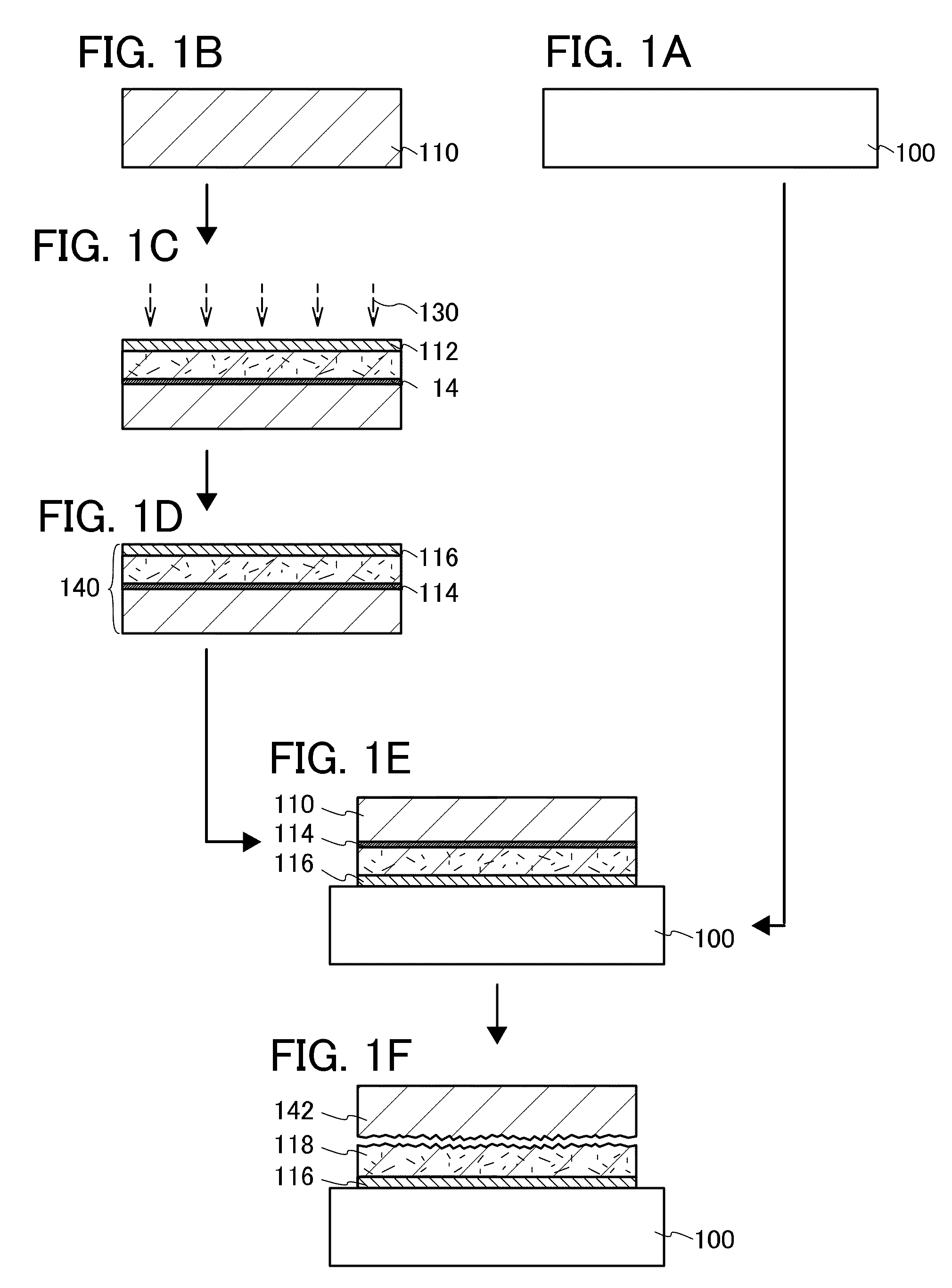Method for manufacturing semiconductor substrate
a manufacturing method and semiconductor technology, applied in semiconductor/solid-state device manufacturing, basic electric elements, electric instruments, etc., can solve the problems of easy generation of defect levels, increase of defects in poor characteristics of semiconductor elements manufactured using single crystal semiconductor layers, etc., to achieve favorable and uniform characteristics, reduce in-plane variation of semiconductor layers, and improve productivity
- Summary
- Abstract
- Description
- Claims
- Application Information
AI Technical Summary
Benefits of technology
Problems solved by technology
Method used
Image
Examples
embodiment 1
[0041]In Embodiment 1, a method for manufacturing a semiconductor substrate which is one embodiment of the disclosed invention will be described with reference to FIGS. 1A to 1F and FIGS. 2A to 2C.
[0042]First, a base substrate 100 is prepared (see FIG. 1A). As the base substrate 100, a substrate having an insulating surface, such as a visible light transmitting glass substrate used for a liquid crystal display device or the like, can be used, for example. As a glass substrate, a substrate having a strain point of 580° C. or higher (preferably, 600° C. or higher) may be used. Further, it is preferable that the glass substrate be a non-alkali glass substrate. As a material of the non-alkali glass substrate, a glass material such as aluminosilicate glass, aluminoborosilicate glass, or barium borosilicate glass is used, for example.
[0043]Note that as the base substrate 100, as well as a glass substrate, a substrate having an insulating surface, such as a ceramic substrate, a quartz subs...
embodiment 2
[0089]In Embodiment 2, a variation of the method for manufacturing a semiconductor substrate in Embodiment 1 will be described. Specifically, the case of employing planarization treatment by etching will be described with reference to FIGS. 3A to 3D and FIGS. 4A to 4D. Note that many parts of a manufacturing process of a semiconductor substrate described in this embodiment are the same as those in Embodiment 1. Thus, description of parts overlapping with those in Embodiment 1 will be omitted below, and differences will be mainly described.
[0090]First, a method illustrated in FIGS. 3A to 3D is described.
[0091]First, in accordance with the method described in Embodiment 1 or the like, a base substrate 100 and a substrate 140 are bonded together, and then, the substrate 140 is divided into a single crystal semiconductor substrate 142, and an insulating layer 116 and a semiconductor layer 118. Accordingly, a semiconductor substrate including the semiconductor layer 118 over the base sub...
embodiment 3
[0107]In Embodiment 3, another example of a method for manufacturing a semiconductor substrate of the present invention will be described with reference to FIGS. 5A to 5E and FIGS. 6A to 6C. Note that many parts of a manufacturing process of a semiconductor substrate described in this embodiment are the same as those in Embodiment 1. Thus, differences will be mainly described.
[0108]First, a base substrate 100 is prepared (see FIG. 5A). Embodiment 1 can be referred to for the details of the base substrate 100. In addition, a single crystal semiconductor substrate 110 is prepared. Embodiment 1 can be referred to also for the details of the single crystal semiconductor substrate 110.
[0109]Next, a variety of treatments are performed on the single crystal semiconductor substrate 110 to form a damaged region 114 and an insulating layer 116 (see FIG. 5B). Embodiment 1 may be referred to for the details of the variety of treatments. Note that the damaged region 114 is a region which contain...
PUM
 Login to View More
Login to View More Abstract
Description
Claims
Application Information
 Login to View More
Login to View More - R&D
- Intellectual Property
- Life Sciences
- Materials
- Tech Scout
- Unparalleled Data Quality
- Higher Quality Content
- 60% Fewer Hallucinations
Browse by: Latest US Patents, China's latest patents, Technical Efficacy Thesaurus, Application Domain, Technology Topic, Popular Technical Reports.
© 2025 PatSnap. All rights reserved.Legal|Privacy policy|Modern Slavery Act Transparency Statement|Sitemap|About US| Contact US: help@patsnap.com



